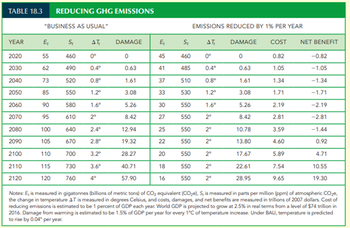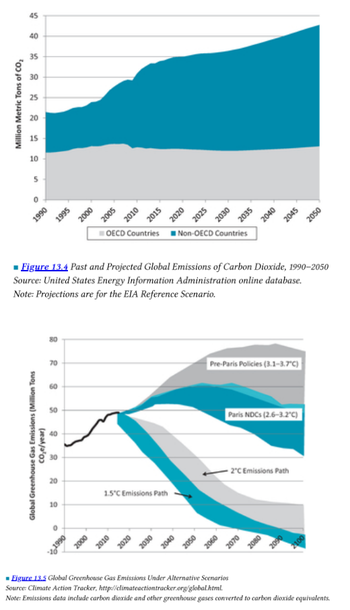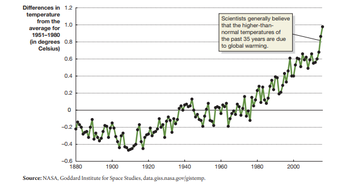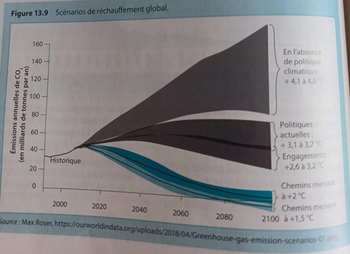- Home
- SUMMARY
- BY TEXTBOOK Apri sottomenù
-
BY TOPIC
Apri sottomenù
- S1 : Greenhouse effect
- S2 : Anthropogenic cause
- S3 : Future scenarios of temperature increases
- S4 : Impacts on Earth’s systems
- S5 : Impacts on economic and social systems
- E1 : Mitigation as a social dilemma
- E2 : Carbon pricing
- E3 : Discounting in reference to climate change
- E4 : Inequality in reference to climate change
- E5 : Social Cost of Carbon and IAMs
- E6 : Persistency & irreversibility in reference to climate change
- E7 : Climate decision-making under uncertainty
- E8 : Climate policies
- E9 : Behavioural issues in reference to climate change
- E10 : Adaptation and geoengineering
- SAMPLE LECTURE
- ABOUT US
S3 : Future scenarios of temperature increases
Any statement that temperatures are likely to increase will be recorded in this section.
US-3-m
624
A 2014 United Nations (UN) report concluded that global warming is occurring and the situation is becoming more serious.
The UN report found that continued emission of greenhouse gases will cause further warming, increasing the likelihood of “severe, pervasive and irreversible impacts for people and ecosystems.”

US-5-m
698
Table 18.3 shows GhG emissions and average global temperature change at ten-year intervals for two scenarios, starting in 2020. The first is a “business as usual” scenario in which GhG emissions are projected to more than double over the next century so that the average GhG concentration rises considerably, and by 2120 the average temperature is 4 degrees Celsius above its current level.
[...]
698- 699
The second scenario shown in Table 18.3 is one in which the GhG concentration is stabilized at 550 ppm so that the temperature increase is limited to only 2 degrees Celsius, which is reached in 2070.

US-6-m
427
As atmospheric concentrations of greenhouse gases increase, the world is expected to become warmer, on average.
[...]
Global average temperatures have already increased by about 1 degree Celsius (1.8 degrees Fahrenheit) over the past several decades. At the 2015 international climate meeting in Paris, nearly 200 nations agreed that it was necessary to limit the eventual warming to “well below” 2 degrees Celsius, and to “pursue efforts” to limit the warming to 1.5 degrees Celsius, based on the scientific consensus that warming above these levels is likely to cause dangerous economic and ecological impacts. Climate scientists have developed complex models to predict how much average temperatures will increase as CO2 concentrations increase. Because predicting long-term climate trends involves considerable uncertainty, these models have produced a range of potential outcomes.
[...]
A 2014 IPCC report concludes […] that “continued emission of greenhouse gases will cause further warming and long-lasting changes in all components of the climate system.” […] The report estimates that the global temperature increase by 2100, relative to the pre-industrial average temperature, will be from 1.0 degree Celsius (1.8 degrees Fahrenheit) to as high as 5.4 degrees Celsius (9.7 degrees Fahrenheit), reflecting uncertainty in both physical modeling and policy actions.
[...]
Scientists at the IPCC estimate that, rather than increasing as projected in Figure 13.4, global CO2 emissions must be reduced 40–70 percent by mid-century, relative to 2010, in order to have a likely chance to limit the temperature increase to no more than 2 degrees Celsius.
429
Prior to the Paris agreement, under existing national policies global greenhouse gas emissions were projected to continue to increase until at least 2050 and potentially until 2090 (the top gray-shaded range of emissions), with an expected global temperature increase between 3.1 and 3.7 degrees Celsius. If all countries meet their Paris NDCs, then global emissions will peak sooner, and will be between 39 percent lower and 6 percent higher than current emissions in 2100 (the higher blue-shaded range of emissions). But the global average temperature will still increase between 2.6 and 3.2 degrees Celsius if all countries meet their NDCs. We see that in order to meet the 2 degrees Celsius target, global emissions will need to begin to decline essentially immediately, and be between 80 percent and 106 percent lower than current emissions in 2100. (Negative net emissions are possible if large amounts of carbon are removed from the atmosphere through expansion of forests or other methods.) Even more dramatic emissions reductions are necessary to achieve the 1.5 degree Celsius target, as shown by the bottom blue-shaded emissions range.

US-7-m
163
In the past 35 years, the global temperature has increased about 0.75 degree Fahrenheit (or 0.40 degree Celsius) compared with the average for the period between 1951 and 1980. The following graph shows changes in temperature in the years since 1880.
164
If greenhouse gases continue to accumulate in the atmosphere, according to some estimates, global temperatures could increase by 3 degrees Fahrenheit or more during the next 100 years.
US-8-m
799-800
According to the Intergovernmental Panel on Climate Change (IPCC), the average temperature "from 1983 to 2012 was likely the warmest 30-year period of the last 1400 years in the Northern Hemisphere." And the trend has not ebbed, as average temperatures in 2018 reached the highest ever recorded in modern times.
US-11-m
366
Under the Paris Agreement, governments will prepare nationally determined contributions (NDCs). NDCs outline a country’s targets to reduce national emissions to limit global temperature rise to 2 degrees Celsius and the steps it has taken to address climate change.
US-16-m
8
The consistent rise in temperature after 1980 suggests that temperatures will continue to rise in every year following 2000.
91
But equally unprecedented has been the rise in surface temperature of the earth.
US-2-M
345
Under the Paris Agreement of 2015, 196 countries agreed to reduce their greenhouse gas emissions in an effort to limit the rise in the earth’s temperature to no more than 2 degrees centigrade.

FR-4-M
310
En l'absence de toute politique climatique, on estime que les températures augmenteraient en moyenne de 4,1 à 4,8 °C à l'horizon 2100 par rapport au niveau qui existait avant la Révolution industrielle. Cela rendrait la planète en grande partie inhabitable. Si les engagements pris à ce jour par les États étaient tenus, la hausse serait de 3,1 à 3,7 °C, ce qui serait déjà catastrophique. De plus, ces engagements ne sont pas contraignants, et les données montrent que de nombreux pays ne les tiennent pas à ce jour, alors que ces engagements sont déjà insuffisants pour limiter le réchauffement à un niveau de 1,5 à 2 degrés, considéré comme la limite acceptable par les scientifiques.
FR-7-M
53
Sans action, les modèles prédisent qu'une hausse de la température de 2 degrés pourrait coûter à l'économie mondiale jusqu'à 2 points de PIB, et qu'une hausse de 3 degrés, 5 points de Produit Intérieur Brut.
FR-2-B
146
L'OCDE prévoit une augmentation de 50 % des émissions de gaz à effet de serre (GES) d'ici 2050 si rien n'est fait de plus que ce qui est prévu, ce qui entraînerait une hausse des températures de 3°C à 6 °C, beaucoup plus que les 2 °C, « point de bascule » calculé par les experts internationaux.
FR-4-B
481
Trois dossiers sont au centre des préoccupations : […] et le réchauffement (ou dérèglement) climatique (2 à 6° d'ici à 2 100).